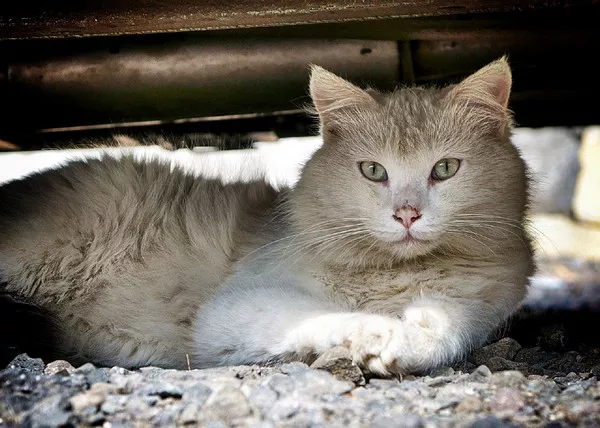Cats are generally clean animals, often grooming themselves to maintain their fur and skin. However, despite their self-cleaning habits, cats can still encounter various health issues, including mite infestations. Mites are microscopic parasites that can cause irritation and discomfort for cats, and they can infest indoor environments as well as outdoor ones. This article will explore how cats get mites indoors, the potential health risks associated with them, and the best ways to prevent and treat these infestations to ensure the health and well-being of your feline friend.
What Are Mites?
Mites are tiny arthropods that belong to the class Arachnida, the same class as spiders and ticks. Unlike fleas and ticks, which are larger and easier to spot, mites are often too small to be seen with the naked eye. Despite their small size, mites can cause significant problems for cats, including skin irritation, hair loss, inflammation, and other health issues.
There are several types of mites that can affect cats, with the most common being:
Ear Mites (Otodectes cynotis): These mites live in the ears and are one of the most common parasitic infestations in cats. They cause itching, head shaking, and discharge from the ears.
Mange Mites (Sarcoptes scabiei and Demodex mites): These mites can cause mange, a condition that results in hair loss, scabs, and itching.
Cheyletiella Mites (also known as walking dandruff): These mites affect the skin and cause scaly, flaky patches, often accompanied by itching.
Though mites are often associated with outdoor cats, they can affect indoor cats as well. But how exactly do indoor cats get mites?
How Do Indoor Cats Get Mites?
Indoor cats are not immune to mite infestations. In fact, they are still at risk, especially if they come into contact with infested objects, animals, or environments. Below are the primary ways indoor cats can get mites:
1. Contact with Other Pets
Even if your cat is strictly indoors, it can still be exposed to mites if you have other pets in the household, such as dogs, rabbits, or other cats. Pets that go outside are at a higher risk of contracting mites, especially ear mites, mange mites, and other external parasites. If a pet with mites enters the house, it can transfer these mites to your indoor cat. Mites are often transmitted through direct contact, such as when pets groom each other or share bedding.
2. Exposure to Contaminated Environments
Mites can be present in the environment and survive on various surfaces, such as furniture, bedding, and carpets. If mites are carried into your home on shoes, clothing, or other objects, they can infest the living space and eventually come into contact with your cat. Mites can live in areas where your cat spends a lot of time, such as near windows, in the corners of rooms, or in areas with little ventilation.
3. Transmission from Stray Animals
Stray cats and other animals that enter the home, even briefly, can bring mites with them. If your indoor cat comes into contact with a stray animal, whether it’s through an open window or door, or through a brief encounter in the yard, it could be exposed to mites. Even animals that seem healthy can carry mites, which is why it’s important to be cautious of any contact with unknown animals.
4. Human Transfer
Though it’s less common, humans can sometimes unknowingly transfer mites to their cats. For example, if you handle an infected animal or come into contact with an infested environment, mites may hitch a ride on your clothing or hands. When you pet your cat or handle its belongings, you could unintentionally introduce mites to its fur or skin.
5. Unsanitary Living Conditions
Cats living in unsanitary conditions are more likely to become infested with mites. Even in an indoor setting, if your home has areas of poor hygiene, such as dirty bedding or unclean litter boxes, your cat may be exposed to mites. The buildup of dust, grime, and organic matter can create an environment where mites thrive, increasing the risk of infestation.
How Mites Affect Cat Health
Mite infestations can lead to a range of health issues for cats, depending on the type of mite and the severity of the infestation. Some of the most common health concerns associated with mite infestations include:
1. Itching and Scratching
One of the most immediate signs of a mite infestation is excessive itching and scratching. Mites irritate the skin, causing your cat to scratch, bite, and lick affected areas in an attempt to relieve the discomfort. This can lead to sores, scabs, and hair loss, which can, in turn, create secondary bacterial infections if left untreated.
2. Hair Loss
Hair loss is another common symptom of mite infestations, particularly with mange mites. The itching caused by the mites leads to excessive grooming, which can cause patches of hair to fall out. In more severe cases, entire sections of a cat’s coat may be affected, leaving the skin exposed and vulnerable to further irritation and infection.
3. Ear Infections
Ear mites, in particular, can cause severe ear infections. These mites thrive in the warm, dark environment of the ears and can cause intense itching, redness, and inflammation. Over time, ear mites can lead to ear infections, which may be accompanied by a foul odor and discharge from the ears. If left untreated, ear infections can lead to more serious health issues, including hearing loss.
4. Inflammation and Redness
Mite infestations can cause inflammation and redness in the affected areas. The constant scratching and irritation can lead to swelling, and the skin may become raw and sore. In some cases, the inflammation can spread to other areas of the body, resulting in a general decline in your cat’s health.
5. Secondary Infections
The damage caused by mites can open the door for secondary infections. When cats scratch and bite at the affected areas, they create breaks in the skin that allow bacteria to enter. This can lead to bacterial infections, which require additional treatment and may worsen your cat’s overall health.
How to Prevent Mite Infestations in Indoor Cats
Preventing mite infestations in indoor cats requires vigilance and a proactive approach. Here are some steps you can take to reduce the risk of mites:
1. Regular Grooming
Regular grooming helps to keep your cat’s coat clean and free from debris. It also allows you to spot any signs of mites or other parasites early on. Brushing your cat’s fur regularly can help to remove dead skin cells, dirt, and mites, preventing infestations from taking hold.
2. Control Other Pets
If you have other pets that go outside, ensure they are regularly treated for mites and other parasites. This will reduce the risk of them bringing mites back into the home. It’s also a good idea to keep your indoor cat separate from outdoor animals whenever possible, especially if the outdoor pets have been in contact with other animals or environments that could harbor mites.
3. Clean the Home Thoroughly
Maintaining a clean home is essential in preventing mite infestations. Regularly vacuuming carpets, cleaning furniture, and washing your cat’s bedding and toys will help to eliminate mites and other pests from the environment. Mites can survive on surfaces for a period of time, so regular cleaning is essential in preventing them from becoming established.
4. Minimize Exposure to Stray Animals
Be cautious about allowing your indoor cat to come into contact with stray animals, as they may carry mites. If you must allow your cat outdoors, supervise it closely to prevent interactions with unknown animals. Keep windows and doors securely closed, and avoid letting your cat roam outside unsupervised.
5. Consult a Veterinarian Regularly
Regular veterinary check-ups are important for maintaining your cat’s health and preventing infestations. Your veterinarian can help detect early signs of mites and recommend appropriate treatments. Additionally, they can provide guidance on flea and mite prevention, ensuring that your cat remains healthy and mite-free.
How to Treat Mite Infestations in Cats
If your cat has been infested by mites, it’s important to seek treatment as soon as possible. Your veterinarian will be able to diagnose the type of mite and recommend the most appropriate treatment plan. Some common treatments for mite infestations include:
Topical Treatments: These include medicated shampoos, ointments, or sprays that kill mites and relieve itching. These treatments are applied directly to the affected areas of your cat’s skin or ears.
Oral Medications: In more severe cases, oral medications may be prescribed to treat mite infestations. These medications work by killing the mites from the inside out.
Ear Drops: If your cat has ear mites, your veterinarian may recommend ear drops to eliminate the infestation and relieve irritation.
Environmental Treatment: Along with treating your cat, you may need to treat your home to eliminate any mites that may be present in the environment. This could involve deep cleaning, vacuuming, and washing bedding, as well as using pest control products recommended by your vet.
Conclusion
While mites are a common problem for cats, they don’t have to pose a serious threat to your cat’s health if addressed early. Indoor cats can get mites through various means, including contact with other pets, contaminated environments, and even human transfer. By maintaining good hygiene, keeping your cat’s environment clean, and seeking prompt veterinary care if an infestation occurs, you can keep your cat healthy and free from the discomfort of mite infestations. Regular grooming and preventive care are essential steps to ensuring that your feline companion remains happy and healthy for years to come.
Related Topics



























